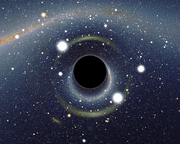
Simulated view of a black hole in front of the Large Magellanic Cloud. The ratio between the black hole Schwarzschild radius and the observer distance to it is 1:9. Of note is the gravitational lensing effect known as an Einstein ring, which produces a set of two fairly bright and large but highly distorted images of the Cloud as compared to its actual angular size.
In general relativity, a black hole is a region of space in which the gravitational field is so powerful that nothing, including light, can escape its pull. The black hole has a one-way surface, called an event horizon, into which objects can fall, but out of which nothing can come. It is called "black" because it absorbs all the light that hits it, reflecting nothing, just like a perfect blackbody in thermodynamics. Quantum analysis of black holes shows them to possess a temperature and Hawking radiation.
No comments:
Post a Comment